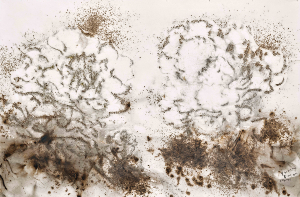This painting is to be sold with a certificate of authenticity issued by Eslite Gallery.
Catalogue Note:
From Quanzhou to Shanghai to Tokyo to New York, the blasting art of Cai Guo-Qiang has stunned the entire world. Transcending imagination, his creative concepts utilize methods, such as installation, conception, and performance, that lead people to experience a magnificent sensory feast as well as open up questions and imaginations regarding human civilization. His interdisciplinary, interregional, and crosscultural works of art evidently contain Eastern colors that originate from China. Using gunpowder as his paintbrush, the artist employs “destruction” to achieve “creation”, while conveying a humanistic care for civilization, history, and even the universe, heaven, and earth.
As a Chinese artist who chose to travel around the world in the late twentieth century, Cai Guo-Qiang took the cultural nutrients of his home country and started writing a splendid chapter on the history of contemporary art drawing from his unique vision and incomparable perseverance. In 1999, Cai Guo-Qiang won the Golden Lion Award at the Venice Biennale for Venice’s Rent Collection Courtyard, becoming the first Chinese artist to receive this honor. I n 2002, Shanghai Art Museum held a large-scale solo exhibition of the artist's works, making it the first exhibition of contemporary art organized by an art museum in China. In 2008, the Guggenheim Museum in New York held a solo exhibition of a Chinese artist for the first time. This artist was none other than Cai. In the summer of 2014, Cai Guo-Qiang, whose works of art have touched countless people in many par t s of the world, once again came to Shanghai. The Power Station of Art located in the Bund presented “Cai Guo-Qiang: The Ninth Wave,” a legendary and well received by the global art scene solo exhibition. This exhibition marked the peak of his artistic career, and “Yellow and White Peonies” has become the best work of this heyday period.
The narrative hidden within Cai Guo-Qiang's works is often grand and profound. He enjoys calling himself, “Boy Cai”, like a child who is unconstrained and courageous enough to pursue his dreams. However, this boy is not only free to be curious and explore, but even his thinking also undoubtedly combines a macroscopic, meticulous, universal, and humanistic spirit. He specializes at producing entirely original projects and presenting his ideas to the world. He invites the public to take part in his projects, and uses visual and sound sensors to encourage them to be more openminded. Cai explores humanity through a more macroscopic and clearer perspective. In an article “Exploding the Channel between Space and Time – On the Art of Cai Guo-Qiang,” scholar Chia Chi Jason Wang wrote: “When facing constant turmoil and uneasiness of the contemporary world, Cai Guo-Qiang is trying to provide an alternative remedy by going into the society. He uses fire as a medicine and presents something what is beyond imagination. In fact, he intends to expose wounded human feelings.” (Cai Guo-Qiang – Hanging out in the Museum, an exhibition catalog published by the Taipei Fine Arts Museum, Taipei)
Cai Guo-Qiang, a well-worn traveller of the world, has always been able to accurately capture the historical materials of a particular region. By restructuring or re-piecing, he executes cultural reproduction, which resonates with the local cultural context. The most valuable is that his works are connected to a local culture and contain universal connotations with a high level of communication. In 2014, when Cai returned to his home country to present a largescale performance, he used gunpowder and a peony flower, which holds a profound level of cultural significance in Chinese history, to ignite a collective cultural memory in his work “Yellow and White Peonies”. Peony, the queen of flowers, is a gorgeous and elegant symbol of grace and prosperity. A poet Liu Yu-Xi of the Tang Dynasty once sang: “Only the
peony is really a national beauty with its bloom shocking the capital.” It is one of the themes Cai often uses to capture the essence of culture. For example, Cai was invited by the Asia-Pacific Economic Cooperation (APEC) held in Shanghai in 2001 to create largescale landscape fireworks that cast thousands of blue peonies in the air, and the opening ceremony of the 2008 Beijing Olympics, Peony once again bloomed in the eyes of the world.
Continuing the smelting of the cultural symbol of a “peony,” Cai Guo-Qiang completed the “Yellow and White Peonies” in 2014. When the carefully laid gunpowder was ignited on the huge piece of paper, the glint of an electric phoenix generated a beautiful appearance. After the smoke settled, it turned out to be a beautiful resurrection. The artist used gunpowder as ink to blow out elegant and nobly stacked petals. The thick carbon leaves were stacked by the black carbon traces. The pursuit and expression of the sense of trace echo an oriental aesthetic tradition. The two peonies on left and right, each of them blooms in different poses. “Yellow and White Peonies” conveys the idea of breaking through. In a devastating blast, a substance breaks and transforms due to burning, and the life-filled peony is born in the fire and smoke containing the courage to destruct and create. It symbolizes the glory and magnificence that has been produced after being in flames.
